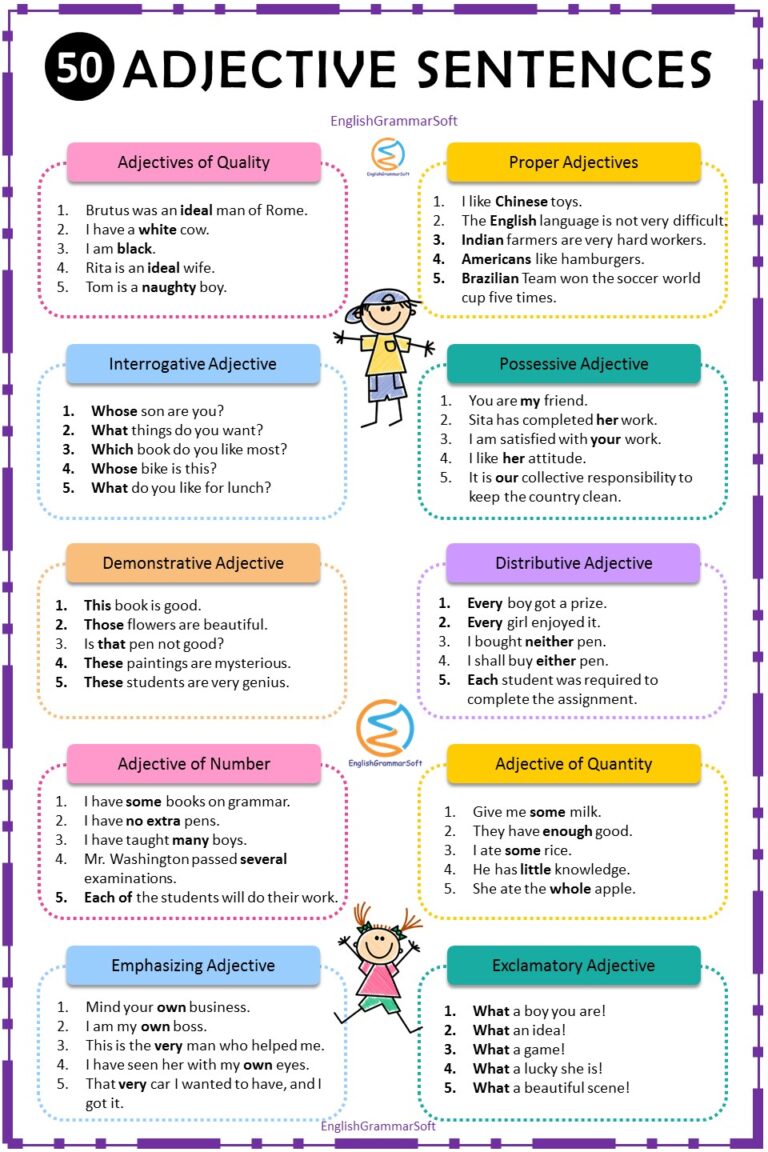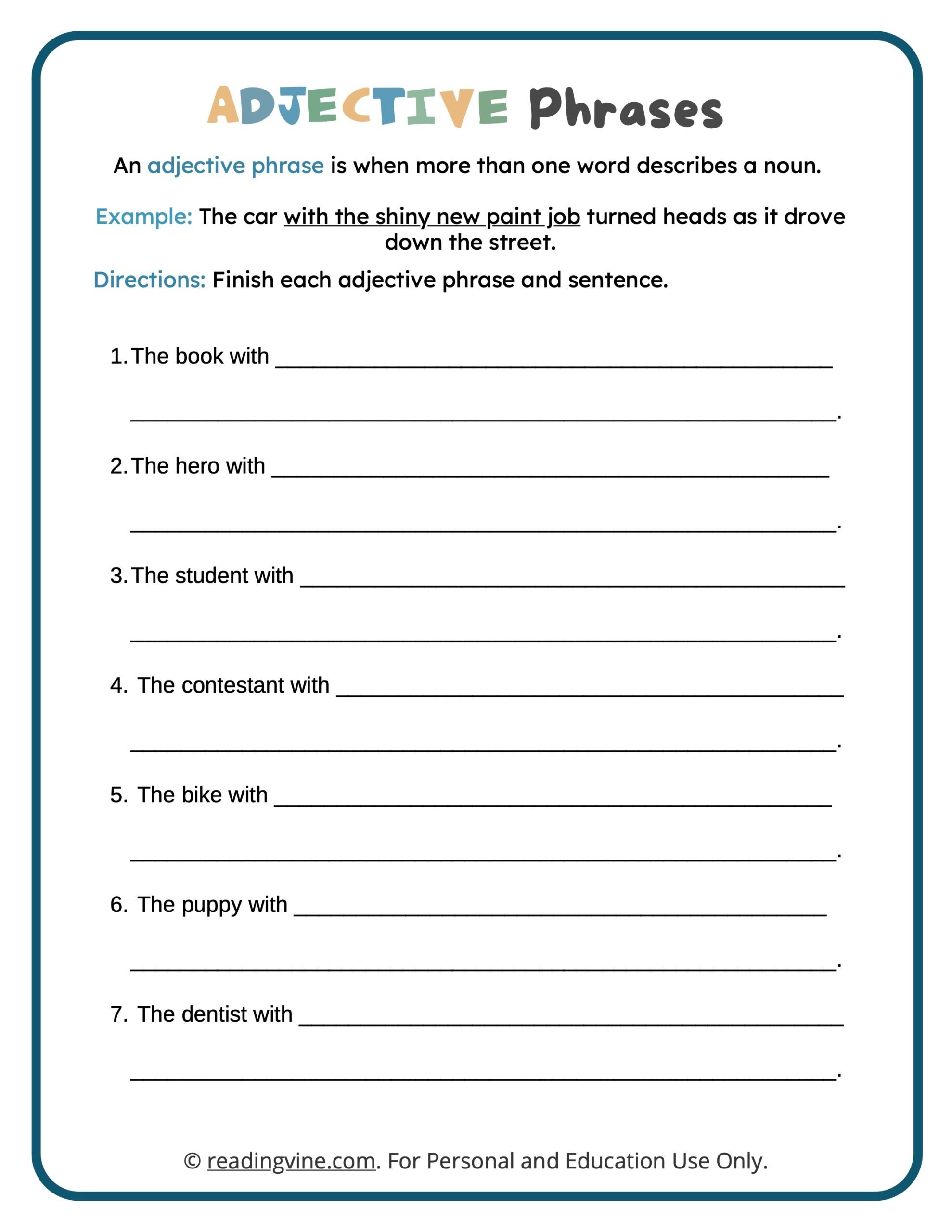
The Art and Science of Adjective Sentence Writing: Crafting Vivid and Impactful Prose
In the vast tapestry of language, words are the threads, and sentences are the intricate patterns we weave. Among these threads, adjectives stand out as the vibrant colors and rich textures, transforming plain descriptions into vivid imagery, and simple statements into compelling narratives. Mastering adjective sentence writing is not merely about adding descriptive words; it’s about precision, impact, and the subtle art of painting with words. This article will delve into the profound importance of adjectives, explore the nuances of their effective use, and provide practical strategies for enhancing your prose through skillful adjective sentence writing.
Understanding Adjectives: The Building Blocks of Description
Before we dive into the art of writing sentences with adjectives, it’s crucial to understand what adjectives are and how they function. At their core, adjectives are words that modify, describe, or qualify nouns and pronouns. They answer questions like:

- Which one? (e.g., this book, those ideas)
- What kind? (e.g., blue sky, difficult task)
- How many? (e.g., three apples, many people)
- Whose? (e.g., my car, her decision – though possessive pronouns often act as adjectives).




Adjectives typically appear in one of two main positions within a sentence:
- Attributive Adjectives: Placed directly before the noun they modify.

- The ancient ruins stood silently.
- She wore a beautiful dress.

- Predicate Adjectives: Follow a linking verb (such as be, seem, become, feel, look, smell, taste, sound) and describe the subject of the sentence.
- The soup was delicious.
- He felt tired after the long journey.


Beyond these basic types, adjectives can also appear in more complex structures, such as adjective phrases (e.g., a man full of wisdom) and adjective clauses (e.g., the house that stood on the hill). Understanding these foundational elements is the first step toward sophisticated adjective sentence writing.
The Power of Precision: Why Adjectives Matter
Imagine reading a story that begins: "A house stood on a hill. A person walked to it. They went inside. It was dark." Now, compare that to: "A decrepit, weather-beaten house stood on a forbidding hill. A solitary, nervous figure walked to its creaking door. They slipped inside, where the eerie darkness enveloped them."
The second example, enriched by well-chosen adjectives, transports the reader, evoking atmosphere, emotion, and clearer imagery. This illustrates the profound power of effective adjective use:
- Creates Vivid Imagery: Adjectives paint pictures in the reader’s mind, allowing them to visualize the scene, character, or object.
- Adds Detail and Specificity: Instead of generic terms, adjectives provide precise information, distinguishing one item from another. "A dog" becomes "a scrappy, three-legged dog."
- Evokes Emotion and Tone: Adjectives can convey the writer’s attitude or elicit specific feelings in the reader (e.g., "a joyful reunion" vs. "a somber gathering").
- Enhances Clarity: By specifying characteristics, adjectives prevent ambiguity and ensure the reader understands exactly what is being described.
- Makes Writing Engaging: Descriptive language holds the reader’s attention and makes the prose more enjoyable and memorable.
Without adjectives, our writing would be stark, bland, and devoid of the nuance that makes language so expressive. The challenge, then, is not just to use adjectives, but to use them judiciously and effectively.
Mastering Effective Adjective Sentence Writing
Skillful adjective sentence writing is a delicate balance between adding sufficient detail and avoiding unnecessary clutter. Here are key strategies to master this art:
1. Choose the Right Adjective: Specificity Over Generality
The most crucial aspect of effective adjective use is selecting words that are precise and impactful. Avoid vague adjectives like "good," "nice," "bad," "big," or "small" when more specific alternatives exist.
-
Instead of: It was a good day.
-
Consider: It was a radiant day. (More specific, conveys atmosphere)
-
Instead of: He had a bad feeling.
-
Consider: He had a foreboding feeling. (More precise, enhances tension)
Use a thesaurus as a tool, but always confirm the connotation of a word. A "large" house might be "spacious," "colossal," or "cramped" depending on the specific feeling you want to convey. Each carries a different implication.
2. Strategic Placement and Order
While attributive and predicate adjectives are common, their placement can subtly alter meaning or emphasis. Consider how multiple adjectives are ordered before a noun:
- Opinion (beautiful, ugly)
- Size (tiny, enormous)
- Age (old, new)
- Shape (round, square)
- Color (red, blue)
- Origin (French, American)
- Material (wooden, silk)
- Purpose (sleeping bag, writing desk)
For example, you’d say "a beautiful old red car," not "a red old beautiful car." While native speakers often do this instinctively, being aware of the order can help when structuring more complex descriptions.
Also, explore placing adjectives in adjective clauses for more complex descriptions:
- The man, who was incredibly brave and unwavering, faced the challenge.
3. Quality Over Quantity: The "Less Is More" Principle
One of the biggest pitfalls in adjective sentence writing is overuse, leading to what is often called "purple prose" – writing that is overly ornate, flowery, and distracting. Too many adjectives can bog down sentences, making them feel heavy and artificial.
- Overuse Example: The bright, shimmering, beautiful, elegant, silk dress caught the dazzling, sparkling, golden light.
- Improved: The shimmering silk dress caught the golden light. (The verbs and nouns do more work, and the adjectives are more impactful.)
Often, a strong noun or verb can eliminate the need for an adjective. Instead of "She walked quickly" (adverb), consider "She raced." Instead of "He made a loud noise," consider "He thundered." This is the essence of "show, don’t tell."
4. Varying Sentence Structure with Adjectives
Adjectives aren’t just for simple sentences. Integrate them into more complex structures to add depth:
- Compound Sentences: The ancient ruins stood silently, and their crumbling walls whispered tales of a forgotten past.
- Complex Sentences (Adjective Clauses): The scientist, who was renowned for her groundbreaking research, presented her revolutionary findings. (Here, "renowned for her groundbreaking research" functions as an adjective clause modifying "scientist.")
- Participial Phrases: The glistening dew, sparkling like diamonds on the grass, promised a beautiful morning. (Here, "glistening" and "sparkling" are participles acting as adjectives.)
Varying how you incorporate adjectives keeps your writing dynamic and engaging.
Common Pitfalls to Avoid in Adjective Sentence Writing
Even experienced writers can fall prey to certain traps when using adjectives. Being aware of these can significantly improve your prose.
- Redundancy: Using adjectives that merely repeat information already conveyed by the noun.
- A circular circle (A circle is inherently circular.)
- A wet rain (Rain is inherently wet.)
- A tall giant (Giants are inherently tall.)
- Weak or Overused Adjectives: As mentioned, avoid "good," "bad," "nice," "very," "really." These often signal a lack of precise vocabulary. Instead of "very happy," consider "elated" or "jubilant."
- Misplaced Modifiers: Placing an adjective or adjective phrase in a way that it modifies the wrong word, leading to confusion or unintended humor.
- Incorrect: He served the dishes to the guests on paper plates. (Were the guests on paper plates?)
- Correct: He served the dishes on paper plates to the guests.
- Confusing Adjectives and Adverbs: Remember, adjectives modify nouns/pronouns, while adverbs modify verbs, adjectives, or other adverbs.
- Incorrect: She sings good. (Good is an adjective.)
- Correct: She sings well. (Well is an adverb here.)
- Not Knowing When Not to Use an Adjective: Sometimes, the most impactful writing comes from letting strong nouns and verbs do the work without any additional modifiers. If a detail isn’t essential for clarity or impact, omit it.
Practical Tips for Improving Your Adjective Sentence Writing
To truly master the art of descriptive language, consistent practice and mindful revision are key.
- Read Actively: Pay attention to how your favorite authors use adjectives. Do they use many, or are they sparse but impactful? How do they create imagery? Analyze their choices.
- Practice Targeted Exercises:
- Take a bland sentence and rewrite it several times, adding different adjectives to change the meaning or tone.
- Describe an object in detail using only adjectives for a minute, then try to integrate those into sentences.
- Write a paragraph without any adjectives, then rewrite it, adding only the most essential ones.
- Edit Ruthlessly: After drafting, go back and scrutinize every adjective. Is it necessary? Is it the most precise word? Can a stronger noun or verb replace it? Eliminate redundancies and clichés.
- Get Feedback: Ask others to read your work and point out areas where descriptions are vague, overwritten, or confusing.
- Use Descriptive Language Prompts: Websites and writing guides often offer prompts that encourage descriptive writing.
- Vary Your Sentence Openings: Don’t always start with the noun. Sometimes an adjective phrase can open a sentence effectively: "Drenched and exhausted, the runner collapsed at the finish line."
Conclusion
Adjective sentence writing is a fundamental skill for any aspiring or seasoned writer. Adjectives are not mere ornaments; they are powerful tools that, when used with precision and intent, can transform mundane prose into vivid, evocative, and deeply engaging narratives. By understanding their function, choosing words wisely, avoiding common pitfalls, and practicing consistently, you can unlock the full descriptive potential of your language. Remember, the goal is not to use the most adjectives, but to use the right adjectives in the right places, allowing your words to paint a clear, compelling, and unforgettable picture for your readers. The journey to masterful descriptive writing is continuous, but with each carefully chosen adjective, your prose will grow richer and more resonant.
